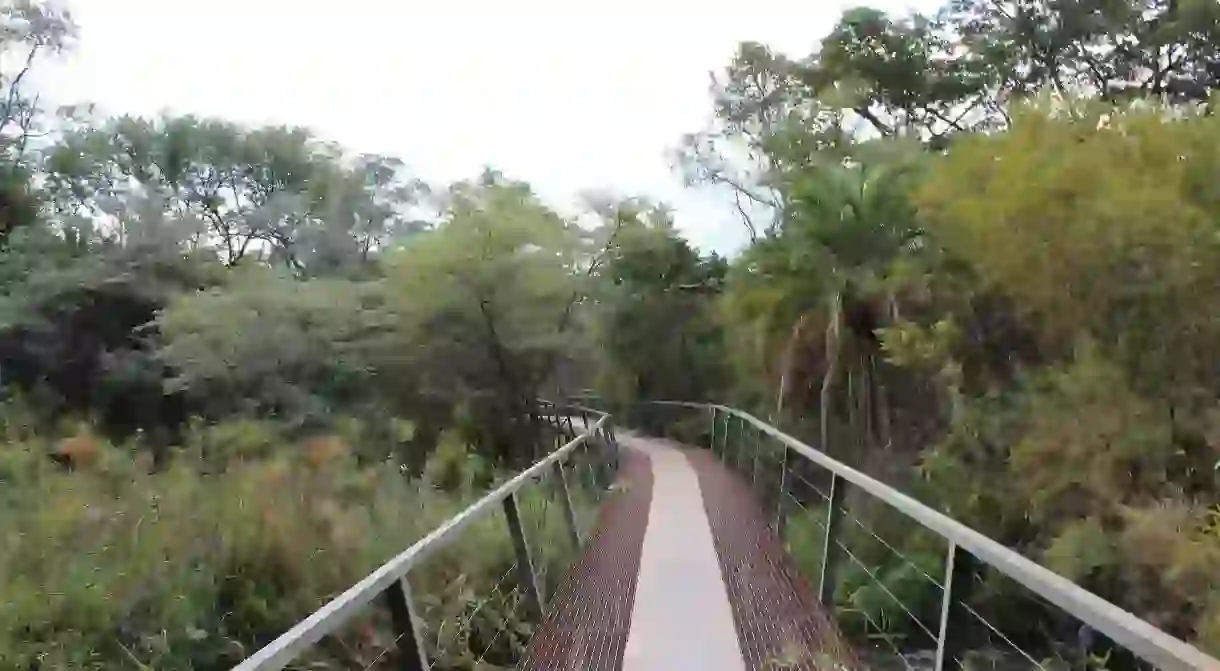The Best National Parks in Namibia

Namibia’s wide open spaces and contrasting landscapes are a visitor’s dream. The best places to see these breathtaking landscapes are in the country’s famed national parks. Here are some of the best national parks that make Namibia a must-see destination.
With almost every tourist marvelling at the fact that you can go from a hot desert terrain to a cool beach front in a matter of minutes, Namibia is a country that will leave you in awe. Home to some of the world’s most spectacular skylines and breathtaking sunsets, Namibia spans a total landmass of 825,615 sq. km (318,771 sq. miles), with a mere 2.48 million people occupying this vast space. The population is diverse, and all thirteen geographical regions feature unique cultural and linguistic features.
Popa Falls Game Park
Natural Feature, Park
Conservations efforts in this park aim to protect its riverine forest east of the Okavango river and the animals found in one of the greenest parts of Namibia. Popa Falls Game Park is Namibia’s smallest game park, measuring a mere 0.25 sq. km (0.01 sq. miles). Its main attraction is the Popa Falls, a set of stunning rapids located in the Kavango River and one of Namibia’s most beautiful hidden gems. There are 417 bird species recorded in the area and visitors can expect to see hippos, vervet monkeys, and many crocodiles, so safety when visiting the riverbeds is of utmost importance.
Waterberg Plateau Park
Natural Feature, Park
Waterberg is one of Namibia’s most historical sites – this is where the historic battle between Herero warriors and German colonial forces took place. It was one the the earliest sanctuaries for endangered species and has thus served as one of Namibia’s most important conservation areas.The park is very small, measuring at a mere 405 sq. km (156 sq. miles). The park is unique for its dinosaur footprints and mysterious rock engravings that appear along its famous plateau.
Etosha National Park, Namibia
Park

Skeleton Coast
Ruins

If mystery, charm and wrecked remains of a sunken past are what you yearn for when travelling, Namibia’s Skeleton Coast is just the destination for you. Considered one of Namibia’s greatest treasures, the national park has also been listed as one of the world’s last greatest wilderness. With an area of 16, 390 sq. km (6,328 sq. miles), the Skeleton Coast is home to animals such as the desert elephant, dolphins, cheetah and 360 bird species. For a complete experience, game viewing and angling should make your to-do list – just make sure to pre-book before entering the park and obtain a valid fishing licence when doing so.
Namib-Naukluft National Park, Namibia
Park

Bwabwata National Park
Hiking Trail, Natural Feature, Park
Situated in the northwestern part of Namibia, Bwabwata National Park covers 6,274 sq. km (2,422 sq. miles) in the Kavango East and Zambezi regions. Fauna and flora includes trees like the Zambezi teak and camelthorn as well as elephant, wildebeest, Cape buffalo and crocodile. Bwabwata is unlike other game parks in that locals also inhabit the park and are actively involved in conservation efforts to protect the area’s wildlife. To the east of the park is the Kwando river, while the Okavango can be found in the western part of the park. Vegetation in this part of Namibia is more lush than most other parts, with low vegetation sand dunes and rivers rendering the area greener.
Sperrgebiet National Park
Hiking Trail, Natural Feature, Park
Another geographical wonder, this national park is littered with meteor crates and is home to some 1,050 plant species which make up 25% of Namibia’s entire flora population. The national park was in previous years closed off to the public to enter and because of this, remains largely un-tainted, featuring some of the world’s most pristine landscapes. Stretching over an area of 22,000 sq. km (8,494 sq. miles), the park is the epitome of Namibia’s contrasting landscapes, from sandy beach shores, mountain ranges and sand dunes.
Dorob National Park
Natural Feature, Park
Dorob National Park is situated along Namibia’s western coast, and links the Skeleton National Park in the north and the Namib Naukluft Park in the south. The park is fairly close to the country’s harbour town, Walvis Bay, as well as Swakopmund, one of the country’s biggest tourist towns. Expect to see seals, dolphins, ostrich and oryx amongst the park’s animal population, with bird life also abudant in the area. With a size of 7,800 sq. km (3,000 sq. miles), Dorob National Park offers various tourist attractions from diverse wildlife, 270 bird species and beautiful natural features largely dominated by dunes and the Atlantic coastline.













